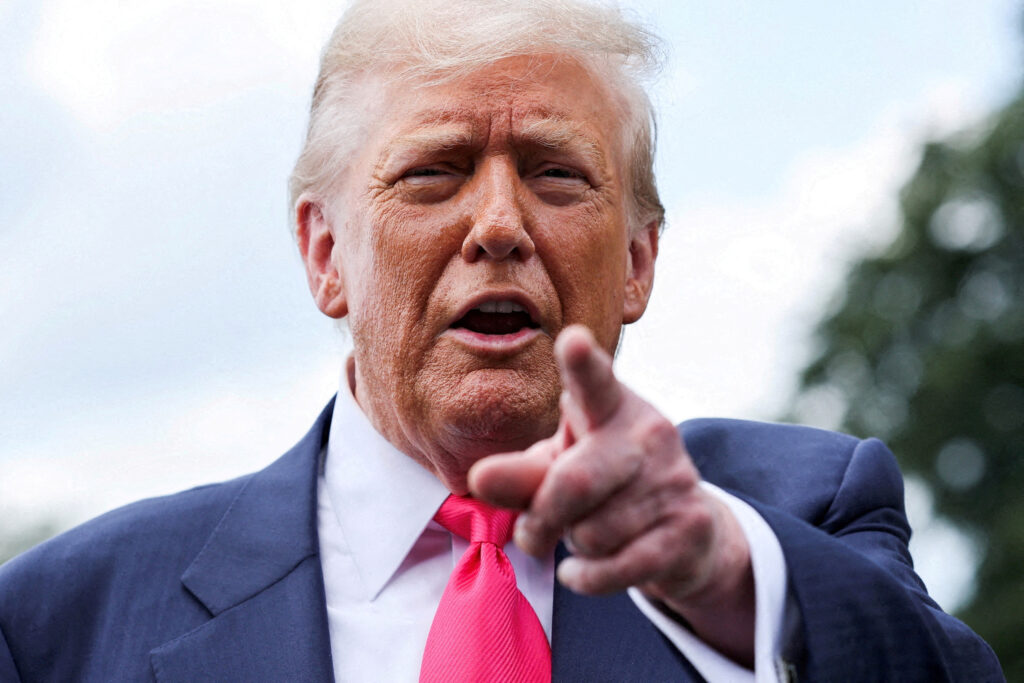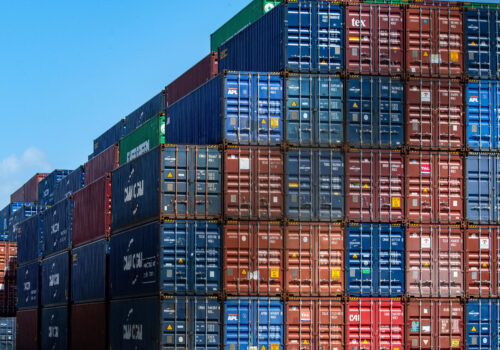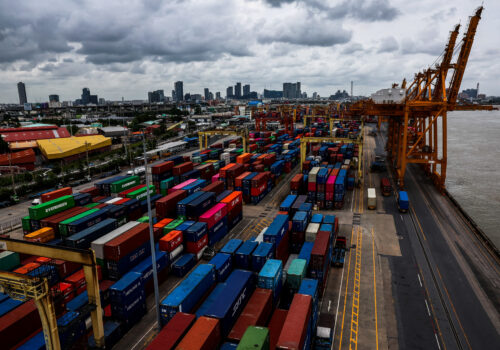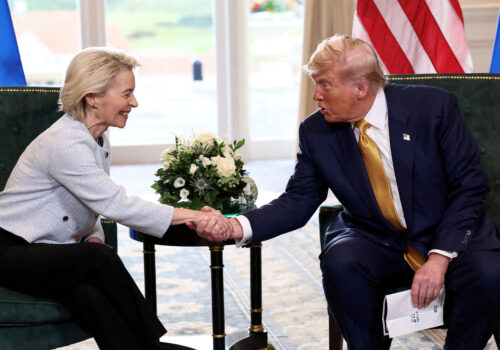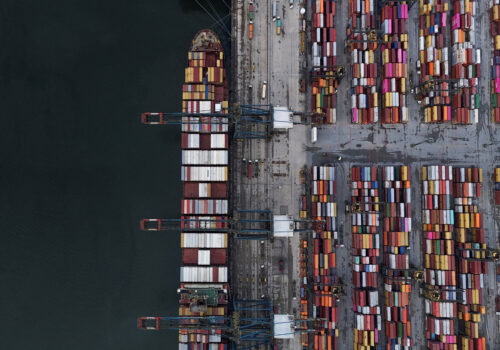In the span of seven months, Donald Trump has remade a global trading system that took over seventy years to construct.
The demolition and reconstruction has been easier than even the US president himself likely imagined. That’s because other countries have been willing to quickly ditch the rules-based trading order that just a few years ago many professed was the bedrock of international economic prosperity.
To appreciate the scale of change, step back from the whirlwind tariff news cycle for a moment. When Trump came into office in January, the effective US tariff rate on the world was approximately 2.5 percent. Today it is more than 15 percent and climbing. When the president’s August tariffs are implemented next week, along with additional sectoral tariffs on copper, pharmaceuticals, and other goods, the US rate will be near 20 percent—the highest in a century and nearly eight times the rate at the start of the year.
It’s difficult in the middle of a tectonic realignment to pinpoint the pivotal moment that signaled things would never be the same. But for me, one image last week captured the new dynamic: European Commission President Ursula von der Leyen sitting at Trump’s golf course in Scotland, about to negotiate a trade deal that was the opposite of the kind of multilateral trade negotiations the European Union (EU) had been involved in for decades.
As recently as April, one week after Trump unveiled his large-scale “Liberation Day” tariffs, the EU’s ambassador to the World Trade Organization (WTO) stated upon the thirtieth anniversary of the institution that “the [Trump] tariffs violate WTO commitments and the basic rules and principles of this organization.” The EU maintained a ““firm commitment,” the ambassador continued, “to rules-based trade, and the WTO is a key foundation of that approach.” Four months later, the rules are being made up as we go, the WTO is nowhere to be seen, and the tariffs are here to stay.
There is no way Trump could have upended the global trading system so quickly without willing partners in other countries.
For decades, the US concept of a trade agreement involved the United States agreeing with another country or a group of countries to drop their tariff and non-tariff barriers in an effort to foster more mutual economic prosperity. This was evident in deals ranging from the North American Free Trade Agreement to the Central America Free Trade Agreement to the US-Korea Free Trade Agreement. But Trump has redefined what a trade deal means. It now entails enshrining high tariffs (but not as high as threatened)—typically 15 percent or more—on another country. In return, the other country commits to make additional investments in the United States.
Why is the world agreeing to this arrangement? First, if a country sees other countries agreeing to similar tariff levels and their economies are competitive in the same sectors (think European, South Korean, and Japanese car makers), then accepting the same baseline tariff rate as those other countries is palatable. Second, that country knows that it is US importers that will pay the new tariff rates, not its own importers. The thinking goes that if the United States wants to tax itself in this way and the country is not getting a different rate than everyone else, so be it.
And why have so many countries, save for China, decided not to retaliate against Trump’s tariffs and instead agreed to deals that seemed impossible just weeks prior? The conventional wisdom is that these countries are calculating that they can’t afford to get into a tit-for-tat escalation like China did because of the United States’ considerable economic leverage. This is only partially true. There is no way Trump could have upended the global trading system so quickly without willing partners in other countries. The fact that so many engaged in these bilateral negotiations, jumping in with promises (however unrealistic they may be) of investments in the United States, reflects frustration that many officials around the world have about the laborious and painful nature of trade negotiations over the past two decades. Consider what former European Trade Commissioner Peter Mandelson, who is now the British ambassador to the United States and played a key role in securing the first trade deal with the second Trump administration, observed in 2008. After the WTO’s Doha Round of negotiations proved unable to reform global trade rules to adapt to the rise of China and India, he described the process as “a collective failure.” In many ways, the trust broken back then was never fully repaired. Yes, Trump has smashed the system, but the speed and scale of the smashing owes to a system that had been growing increasingly brittle for years.
All this leaves the global trading system in a confused and contradictory state. In such a situation, other economic powers like the EU will likely pursue a dual system, in which trade deals with the United States are treated differently than agreements with countries such as Indonesia or nations in Latin America. The EU believes it can engage in trade negotiations as it always has through a system and process. But there is a problem with this theory. The reason the global trading system has worked—until it didn’t—is that the world’s most militarily and economically powerful nation was willing to submit itself to the same rules as everyone else. Without the United States embedded in this framework, the incentives for every other country to play by the old rules will quickly evaporate.
Many countries beyond the EU may believe they’ll be able to reset to the old way of doing business after the Trump administration leaves office. Perhaps this is why several of the deals Trump has struck with trading partners involve three-year investment commitments. But future US presidents, whether Republican or Democratic, will find it hard to simply drop tariff rates back to previous levels when they come into office. Since the EU, for example, already has committed to reduce tariff rates on US imports to near zero, it will make little sense for a future US administration to simply revert to the old system without getting anything in return.
Since the creation of the General Agreement on Tariffs and Trade in 1947, which evolved into the WTO, successive US administrations of both political parties generally have believed that free trade served US interests by strengthening trading ties, spurring the economic growth of neighbors, delivering cheaper goods at home, and showing that a hegemon could operate within a multilateral system. This system was never fully functional, but US leaders always viewed it as better than a protectionist alternative. Trump believes differently, and he is now resetting the global trading system according to his preferences. The rest of the world is adapting very quickly.
Josh Lipsky is the chair of international economics at the Atlantic Council and senior director of the Atlantic Council’s GeoEconomics Center.
Further reading
Fri, Aug 1, 2025
What to watch as Trump ratchets up global tariffs
Fast Thinking By
US President Donald Trump will raise tariffs on nearly every US trading partner. Atlantic Council experts take stock of what this means for the global economy.
Mon, Jul 28, 2025
Trump and von der Leyen made a deal. But the US and EU are drifting apart on trade.
New Atlanticist By Frances Burwell
Many elements of the Turnberry deal still need to be finalized, and the difficult process could drive the two sides even further apart.
Thu, Jul 17, 2025
The numbers that define the US-Brazil trade partnership
New Atlanticist By Valentina Sader, Ignacio Albe
The US president has threatened to impose a 50 percent tariff on Brazil in August. Before then, take a deep data dive into the current bilateral trade relationship.
Image: US President Donald Trump speaks with reporters, as he departs for travel to Pennsylvania from the South Lawn at the White House in Washington, D.C. U.S., July 15, 2025. REUTERS/Jonathan Ernst/File Photo/File Photo
